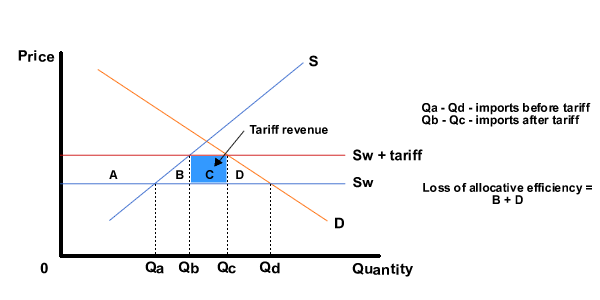Arguments against protectionism
Syllabus: Discuss the arguments against trade protection, including:- a misallocation of resources,
- the danger of retaliation and “trade wars”,
- the potential for corruption,
- increased costs of production due to lack of competition,
- higher prices for domestic consumers,
- increased costs of imported factors of production and
- reduced export competitiveness.
 Various arguments are used against protectionism. These include:
Various arguments are used against protectionism. These include:
- Inefficiency of resource allocation in the long run - the imposition of tariffs, or other protectionist measures, in the long run results in losses of allocative efficiency. Protected producers are not exposed to international competition,do not have enough incentive to decrease costs or innovate and, in the long run, become less competitive and fall behind the rest of the world. In addition, tariffs increase prices in the domestic market and distort the price signals directing investments towards inefficient industries.
- Downward multiplier effects - if a country protects against imports, this will reduce the exports of other countries and their aggregate demand and national output. Consequently, they will import less as the level of imports is a function of national income level. This process could continue and result in a decrease in world production and income.
- Retaliation - protectionist measures tend to be met with some form of retaliation. This will mean that any success in protecting against imports is likely to result in a fall in exports.
- Loss of allocative efficiency (welfare loss) in the short run - a tariff leads to a reduction in imports and increases the price. There is a loss of consumer surplus (part of consumers' welfare shown as areas A, B, C and D in the diagram below). Some of the welfare loss is transferred to the government (tariff revenue shown as area C), and some to producers (shown as area A). There is also welfare cost to society (loss to consumers that is not transferred to anybody else) represented by areas B and D.

Figure 1 The impact of a tariff
- Bureaucracy - many protectionist measures are bureaucratic to enforce and result in extra cost to society.
However, completely free trade may also create additional costs to the economy and to society, for instance:
- Adjustment costs - changes in comparative advantage may require adjustments in the structure of industry, which may take some time and cause temporary increases in unemployment.
- Environmental costs - free trade may encourage firms to relocate to countries, where environmental and other regulations are more relaxed and compliance costs are lower. Although, this may increase producers' profits, it may lead to long-term environmental problems.
